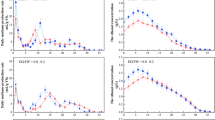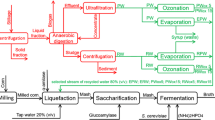abstract
In beet distilleries, condensates arising from stillage concentration could be recycled as dilution water for the fermentation step, thus preserving groundwater resources and ensuring a quality-controlled water supply. However, the recycling of condensates has been found to cause a significant reduction in fermentation activity. This study aimed to verify that condensates are toxic to alcoholic fermentation. Ten compounds found in condensates (formic, acetic, propionic, butyric, valeric, and hexanoic acids; 2,3-butanediol, furfuryl alcohol, furfural, and 2-phenyl-ethyl-alcohol) were tested. With the exception of 2,3-butanediol, they all proved to be inhibitors. At the same molar concentration,the longer the carbonaceous chain, the stronger the inhibition by fatty acids. An experimental design was used to study the inhibitory characteristics of the 10 compounds at the concentrations found in condensates. Synergistic effects were also confirmed. In real effluents, acetic acid was so highly concentrated that it became the strongest inhibitor. It is therefore necessary to eliminate it before recycling, as well as less concentrated compounds that may accumulate, as illustrated by the simulation.
Similar content being viewed by others
References
Morin Couallier, E. (2004), PhD thesis, Ecole Nationale Supérieure des Industries Agricoles et Alimentaires, Massy, France.
Lafon-Lafourcade, S., Geneix, C., and Ribéreau-Gayon, P., (1984), Appl. Environ. Microbiol. 47, 1246–1249.
Ravaglia, S. and Delfini, C., (1994), Wein-Wissenschaft 49, 40–45.
Viegas, C. A. and Sa-Correia, I., (1995), Enzyme Microb. Technol. 17, 826–831.
Stark, D., Münch, T., Sonnleitner, B. Marison, I. W., and von Stockar, U. (1998), in 2nd European Symposium on Biochemical Engineering Science, Porto.
Edwards, C. G., Reynolds, A. D., Rodriguez, A. V., Semon, M. J., and Mills, J. M. (1999), Am. J. Oenol. Viticul. 50, 204–210.
Luo, C. D., Brink, D. L., and Blanch, H. W., (2002), Biomass Bioenergy 22, 125–138.
Martin, C., Gable, M., Nilvebrant, N.O., and Jönsson, L. J., (2002), Appl. Biochem. Biotechnol. 98–100, 699–716.
Zaldivar, J. and Ingram, L. O., (1999), Biotechnol. Bioeng. 66, 203–210.
Zaldivar, J., Martinez, A., and Ingram, L. O., (1999), Biotechnol. Bioeng. 65, 24–33.
Gutierrez, T., Buszko, M. L., Ingram, L. O., and Preston, J. F., (2002), Appl. Biochem. Biotechnol. 98–100, 327–340.
Sene, L., Converti, A., Zilli, M., Felipe, M. G. A., and Silva, S. S., (2001), Appl. Microbiol. Biotechnol. 57, 738–743.
Thomasser, C., Danner, H., Neureiter, M., Saidi, B., and Braun, R., (2002), Appl. Biochem. Biotechnol. 98–100, 765–773.
Stevens, S. and Servaas Jofmeyr, J.-H., (1993), Appl. Microbiol. Biotechnol. 38, 656–663.
Stratford, M. and Aslow, P. A., (1996), FEMS Microbiol. Lett. 142, 53–58.
Larue, F., Lafon-Lafourcade, S., and Ribéreau-Gayon, P., (1984), Biotechnol. Lett. 6, 687–692.
Maiorella, B., Blanch, H. W., and Wilke, C. R., (1983), Biotechnol. Bioeng XXV, 103–121.
Bouix, M. and Leveau, J. Y., (1993) in Microbiologie industrielle, les micro-organismes d’intérêt industriel, Leveau, J. Y. and Bouix, M., eds., Te. et Doc. Lavoisier, Paris, pp. 2–100.
Morin, E., Bleton, J., Lameloise, M. L., Tchapla, A., and Decloux, M., (2003), Industries Alimentaires Agricoles 7–8, 15–21.
Thomas, K. C., Hynes, S.H., and Ingledew,W. M., (2002), Appl. Environ. Microbiol. 68, 1616–1623.
De Miniac, M., (1984), Industries Alimentaires Agricoles 101, 123–135.
Weast, R. C., (1985), in Handbook of Data on Organic Compounds, Weast, R. C. and Astle, M. J., eds., CRC Press, Boca Raton, IL.
Author information
Authors and Affiliations
Rights and permissions
About this article
Cite this article
Couallier, E.M., Payot, T., Bertin, A.P. et al. Recycling of distillery effluents in alcoholic fermentation. Appl Biochem Biotechnol 133, 217–237 (2006). https://doi.org/10.1385/ABAB:133:3:217
Received:
Revised:
Accepted:
Issue Date:
DOI: https://doi.org/10.1385/ABAB:133:3:217




